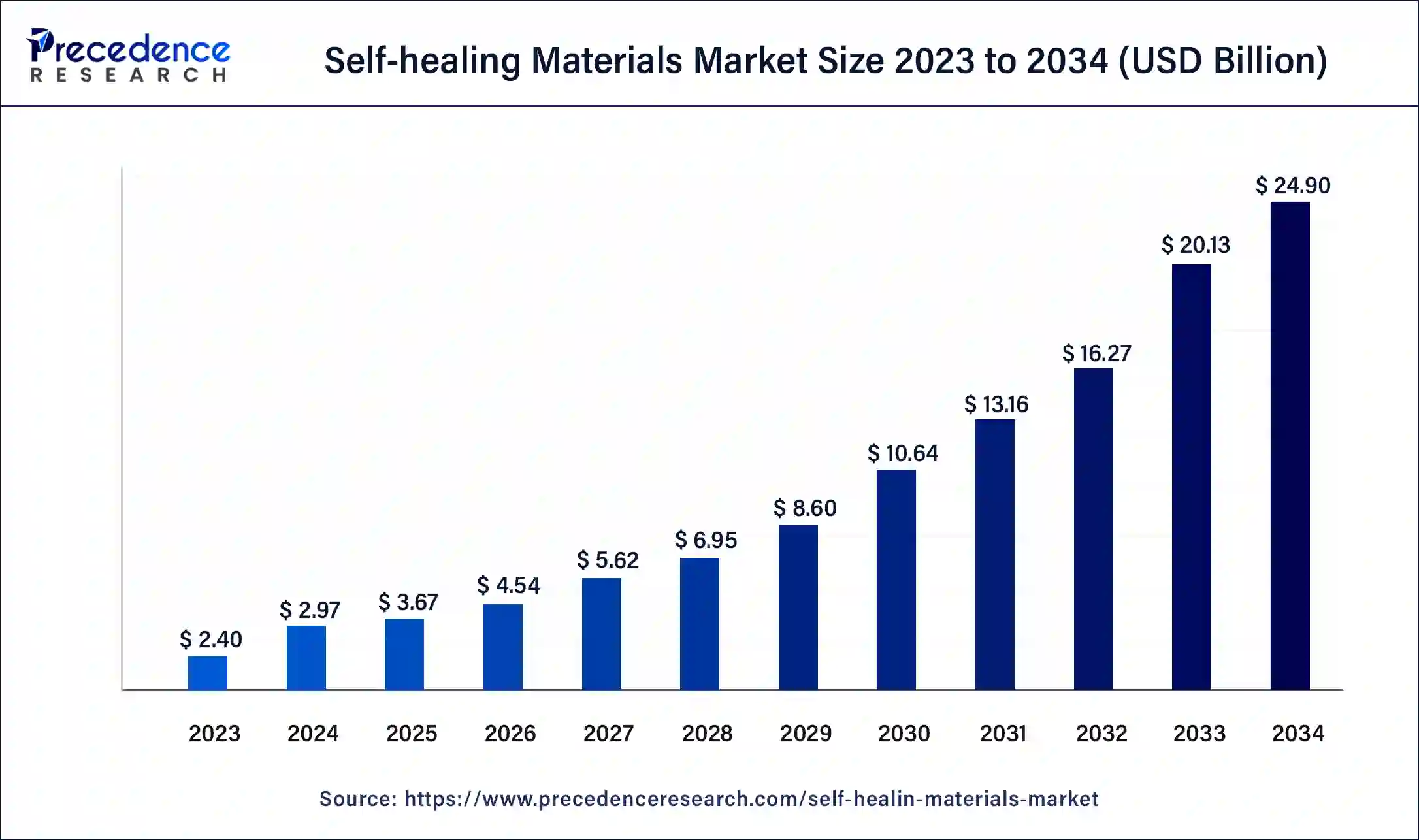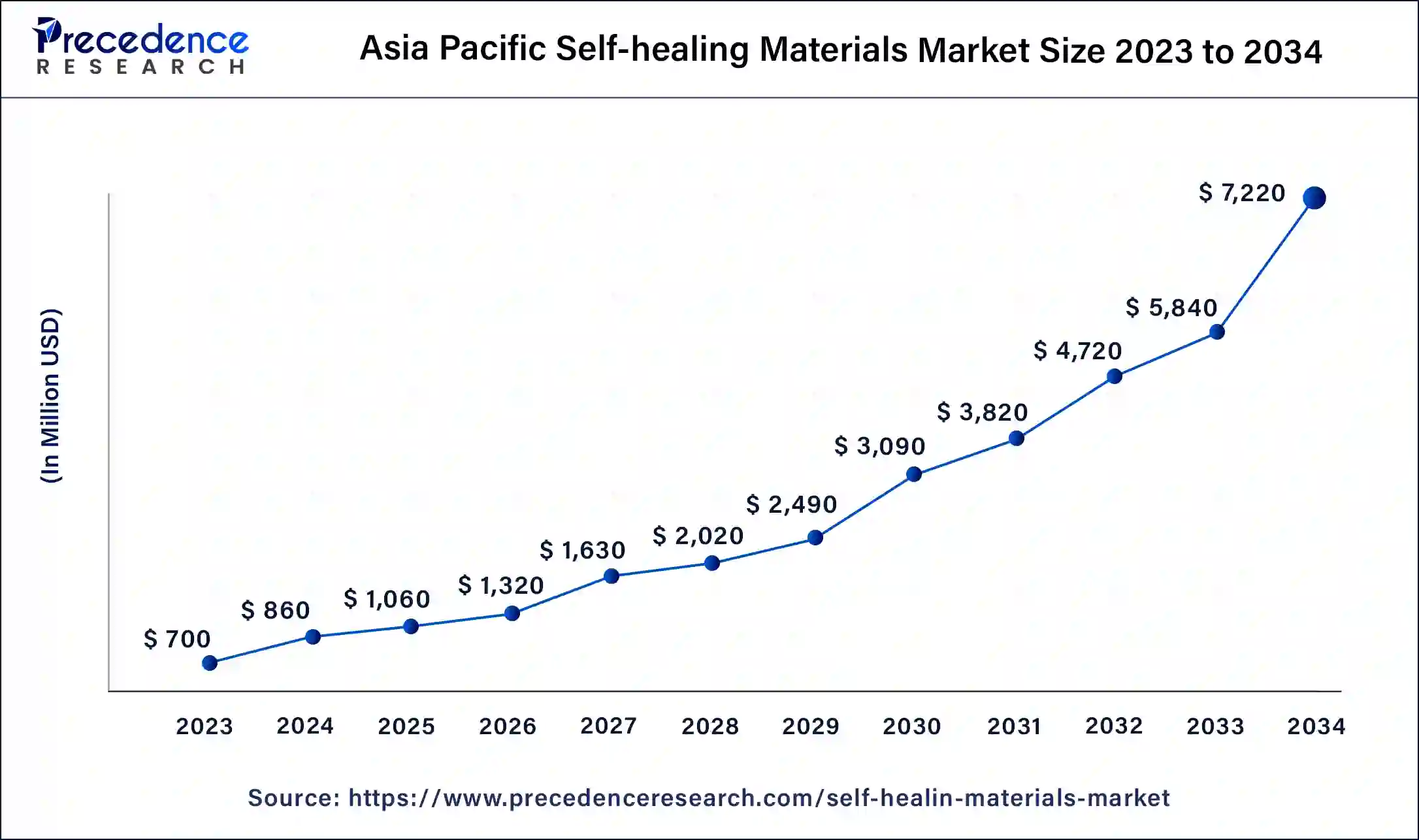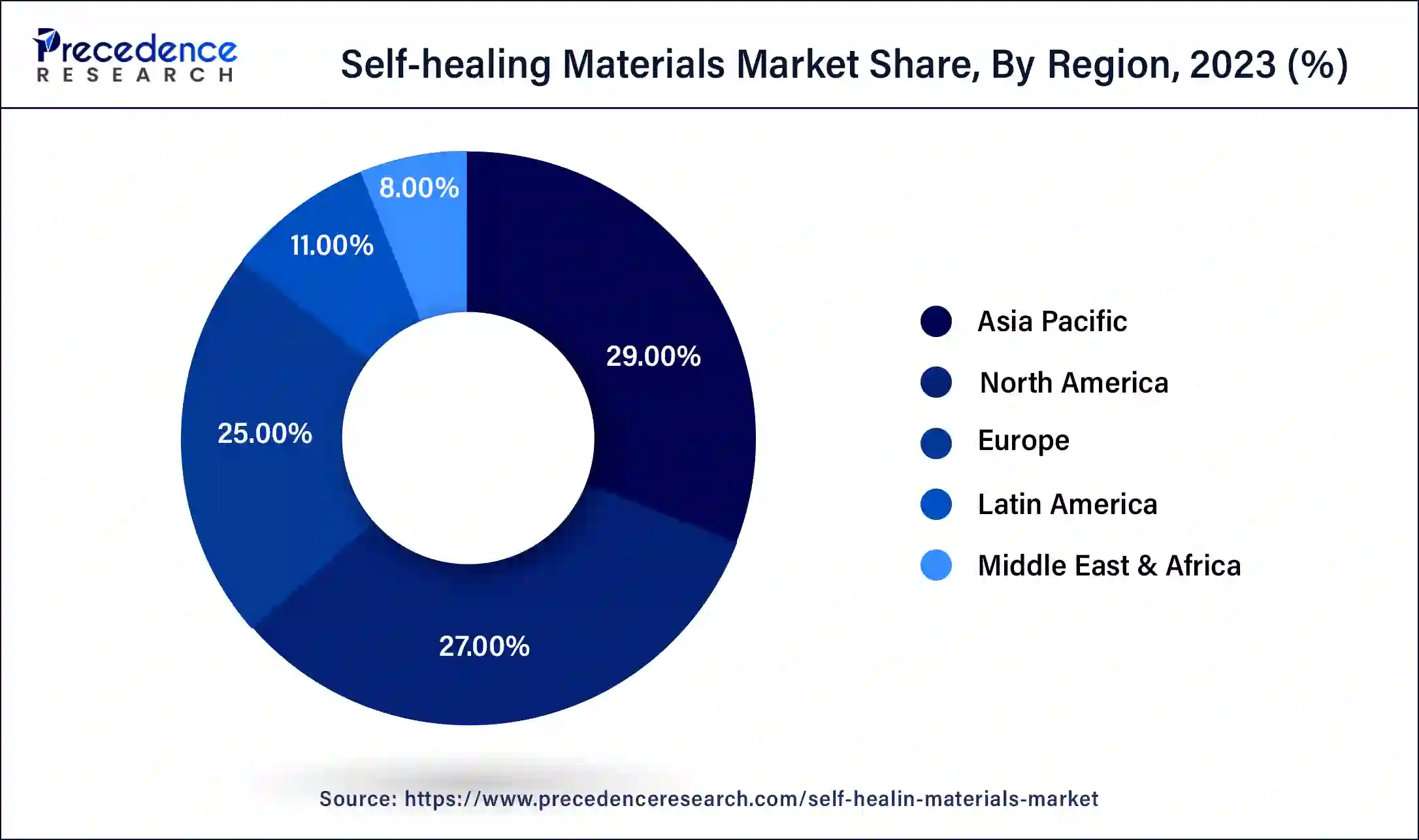Self-healing Materials Market Size and Forecast 2025 to 2034
The global self-healing materials market size was estimated at USD 2.97 billion in 2024 and is predicted to increase from USD 3.67 billion in 2025 to approximately USD 24.90 billion by 2034, expanding at a CAGR of 23.69% from 2025 to 2034.

Self-healing Materials Market Key Takeaways
- In terms of revenue, the self-healing materials market is valued at $3.67 billion in 2025.
- It is projected to reach $24.90 billion by 2034.
- The self-healing materials market is expected to grow at a CAGR of 23.69% from 2025 to 2034.
- Asia Pacific dominated the market with the largest share of 29% in 2024.
- By product type, the polymer segment dominated the market in 2024.
- By product type, the concrete segment shows notable growth during the forecast period.
- By technology type, the encapsulated ascorbic acid segment dominated the market in 2024.
- By technology type, the skin better science segment held a significant share in 2024.
- By application, the microencapsulation segment dominated the market in 2024.
- By application, the shape memory polymers segment is expected to witness significant growth in the market during the forecast period of 2025-2034.
Asia Pacific Self-healing Materials Market Size and Growth 2025 to 2034
The Asia Pacific self-healing materials market size was estimated at USD 860 million in 2024 and is predicted to be worth around USD 7,220 million by 2034, at a CAGR of 23.71% from 2025 to 2034.

Asia Pacific currently leads the self-healing materials market, driven by rapid industrialization, infrastructure development, and a growing focus on sustainability. The region benefits from a large manufacturing base, increasing investments in research and development, and rising awareness about the benefits of self-healing materials in mitigating maintenance costs and improving product reliability. Additionally, government initiatives promoting technological innovation and sustainable development further propel the adoption of self-healing materials across diverse applications in the Asia Pacific.

Asia Pacific is poised to become a significant player in the global self-healing materials market as the region continues to witness economic growth and technological advancements, coupled with the increasing demand for durable and sustainable materials. Moreover, collaborations between regional and international players and supportive regulatory frameworks are expected to accelerate the penetration of self-healing technologies, contributing to the region's position as a key growth market in the coming years.
North America is emerging as a promising presence in the self-healing materials market, propelled by extensive research and development activities, robust technological infrastructure, and a high demand for advanced materials across various industries. The region boasts a strong presence of key market players, coupled with significant investments in innovation, fostering the development and commercialization of self-healing technologies. Industries such as automotive, aerospace, and electronics in North America prioritize the adoption of self-healing materials to enhance product lifespan, reduce maintenance costs, and improve safety.
Europe is observed to grow at a considerable growth rate in the upcoming period, propelled by rising demand in sectors such as construction, automotive, electronics, and aerospace. This region is adopting technologies with a focus on sustainability, supported by robust research and innovation efforts aimed at developing cutting-edge self-healing solutions. Government initiatives promoting eco-friendly materials and enhancing infrastructure durability are facilitating broader acceptance. Moreover, the presence of major market players and growing awareness about the benefits of minimizing maintenance costs and prolonging material lifespan further contribute to market growth across Europe.
Germany
Germany plays a pivotal role in the European self-healing materials market, spurred by its sophisticated industrial environment and dedication to sustainable innovation. The nation exhibits significant adoption in automotive and construction sectors, where durability and long-term performance are highly valued. Collaboration between research institutions and industry fosters advancements in material science, enabling the development of smart materials with self-repairing characteristics for applications in structuring, coatings, and packaging.
Market Overview
The self-healing materials market offers a class of synthetic materials with the remarkable ability to repair damage autonomously, mimicking the healing process found in living organisms. Typically, these materials incorporate microcapsules containing healing agents, such as adhesives or polymers, dispersed throughout their structure. When damage occurs, these capsules rupture, releasing the healing agents to fill and seal the cracks or fractures, thus restoring the material's integrity.
These materials find applications across various industries, including automotive, aerospace, electronics, and construction. In the automotive sector, self-healing polymers are utilized in coatings to prevent scratches and chips on vehicle surfaces, maintaining aesthetic appeal and reducing maintenance costs. Similarly, in aerospace, self-healing composites enhance the structural integrity of aircraft components, improving safety and longevity. In electronics, self-healing materials protect circuits from wear and tear, extending the lifespan of devices and reducing the need for repairs or replacements.
Self-healing materials hold promise in infrastructure development, where they can be integrated into building materials to enhance durability and resilience against environmental factors such as corrosion and fatigue. In the medical field, self-healing hydrogels show potential for tissue engineering and drug delivery systems, offering novel solutions for wound healing and controlled release of pharmaceuticals. Overall, self-healing materials represent a groundbreaking advancement with wide-ranging implications for enhancing the longevity, safety, and sustainability of various products and infrastructures.
- In October 2023, United States Steel Corporation and DuPont proudly unveiled COASTALUME™, North America's pioneering GALVALUME material steel tailored for coastal settings. This innovative product amalgamates the robustness and self-healing attributes of U. S. Steel's GALVALUME material with DuPont's Tedlar PVF film barrier, providing unparalleled resistance to saltwater corrosion, UV damage, cracking, and impacts.
Self-healing Materials Market Growth Factors
- Continuous advancements in material science, chemistry, and engineering drive innovation in self-healing materials. Researchers are developing new techniques and formulations to enhance healing capabilities, durability, and versatility. Breakthroughs in microencapsulation, shape memory polymers, and nanotechnology enable the creation of self-healing materials with improved performance and functionality, expanding their applicability across various industries.
- With increasing environmental concerns, there is a growing demand for sustainable materials and technologies. Self-healing materials offer a promising solution by reducing the need for frequent replacements and repairs, thereby minimizing material waste and resource consumption. Industries seeking to enhance sustainability and reduce their carbon footprint are increasingly turning to self-healing materials as a viable alternative to traditional materials.
- Self-healing materials offer significant cost savings by reducing maintenance expenses and extending the lifespan of products and infrastructure. By autonomously repairing damage, these materials minimize downtime, labor costs, and the need for costly replacements. Industries such as automotive, aerospace, and construction benefit from improved operational efficiency and reduced lifecycle costs, driving the adoption of self-healing materials.
- Various industries, including automotive, aerospace, electronics, healthcare, and infrastructure, are increasingly incorporating self-healing materials into their products and processes. These materials offer unique advantages such as enhanced safety, reliability, and longevity, addressing critical needs in sectors where performance and durability are paramount. The widespread adoption of self-healing materials across diverse industries further fuels the growth of the self-healing materials market.
- Government initiatives and regulations promoting technological innovation, sustainability, and safety also contribute to the growth of the self-healing materials market. Supportive policies and funding for research and development encourage collaboration between academia, industry, and government agencies, accelerating the development and commercialization of self-healing technologies. Moreover, the establishment of standardized testing methods and performance criteria ensures quality and reliability, fostering consumer confidence and acceptance of the self-healing materials market.
Major Key Trends in Self-healing Materials Market:
- Rising Use in Construction: The application of self-healing materials is on the rise in civil infrastructure to boost durability, reduce maintenance requirements, and extend the longevity of structures, aligning with the movement toward sustainable construction practices.
- Innovation in Polymer Systems: Cutting-edge polymer-based self-healing technologies are becoming increasingly popular due to their versatility, ease of processing, and applicability across various sectors, including electronics, coatings, and consumer products.
- Sustainability-Driven Adoption:The growing focus on environmental issues is prompting industries to incorporate self-healing materials that help to minimize waste, preserve resources, and facilitate a transition toward more environmentally friendly and durable material solutions
Market Scope
| Report Coverage | Details |
| Market Size by 2034 | USD 8.10 Billion |
| Market Size in 2025 | USD 3.67 Billion |
| Market Size in 2024 | USD 8.10 Billion |
| Market Growth Rate from 2025 to 2034 | CAGR of 23.69% |
| Largest Market | North America |
| Base Year | 2024 |
| Forecast Period | 2025 to 2034 |
| Segments Covered | Product, Technology, and Application |
| Regions Covered | North America, Europe, Asia-Pacific, Latin America, and Middle East & Africa |
Market Dynamics
Drivers
Enhanced safety and reliability with self-healing materials
Self-healing materials offer a revolutionary solution to enhance the safety and reliability of critical components in industries such as aerospace, automotive, and medical fields. By autonomously repairing damage, these materials mitigate the risk of catastrophic failures that could have severe consequences. For instance, in aerospace applications, self-healing composites can prevent cracks from propagating, ensuring the structural integrity of aircraft components.
In the automotive sector, self-healing coatings protect vehicle surfaces from scratches and chips, maintaining both aesthetics and safety. In medical devices, self-healing materials enhance reliability by preventing leaks or fractures, crucial for ensuring patient safety and device functionality. Overall, the ability of self-healing materials to self-repair damage contributes significantly to the safety and reliability of critical components across various industries.
- In August 2023, Chinese e-scooter manufacturer Yadea introduced the KS6 Pro electric scooter, an upgraded iteration of the KS5 Pro model. Boasting a triple braking system and a commendable range of approximately 34 miles (~55km), the KS6 Pro prioritizes safety with its 10-inch self-healing tubeless tires.
Environmental sustainability with self-healing materials
Self-healing materials play a pivotal role in promoting environmental sustainability by reducing material waste and energy consumption associated with traditional repair and replacement processes. By autonomously repairing damage, these materials extend the lifespan of products and infrastructure, minimizing the need for frequent replacements and reducing the overall demand for raw materials. This leads to a significant reduction in waste generation and resource depletion.
Additionally, the self-repair process requires minimal external energy input, further reducing the carbon footprint associated with maintenance activities. Industries adopting self-healing materials, such as construction, transportation, and electronics, can significantly lower their environmental impact while improving the longevity and performance of their products. Overall, self-healing materials represent a promising avenue for achieving sustainability goals and fostering a more environmentally friendly approach to manufacturing and maintenance practices.
Restraint
Navigating regulatory hurdles on challenges in adopting self-healing materials in regulated industries
The incorporation of self-healing materials in regulated sectors like aerospace and healthcare faces obstacles due to rigorous regulatory standards and a shortage of standardized testing protocols. Complying with safety and performance criteria is paramount for widespread commercial acceptance. However, the absence of universally accepted testing methodologies complicates the validation process. Overcoming these challenges necessitates concerted efforts to establish clear regulatory pathways and develop standardized testing frameworks tailored to the unique characteristics of self-healing materials, facilitating their integration into highly regulated industries.
Opportunities
Extended product lifespan
Self-healing materials revolutionize product longevity by autonomously repairing damage, thereby mitigating the need for frequent replacements. This not only reduces the environmental impact associated with manufacturing and disposal but also translates into substantial cost savings for consumers and industries alike. By enhancing durability and resilience, self-healing materials ensure that products maintain their functionality and structural integrity over an extended period, delivering value and sustainability in various applications from electronics to infrastructure.
Technological breakthroughs on self-healing materials pioneering innovation
The emergence of self-healing materials as a cutting-edge technology drives innovation across material science, chemistry, and engineering disciplines. By pushing the boundaries of traditional material design, researchers develop novel solutions that offer unprecedented functionalities and performance. These advancements open up a multitude of applications across diverse industries, from aerospace to consumer electronics, unlocking new possibilities and benefits. The ongoing pursuit of self-healing materials fosters collaboration and cross-disciplinary research, fueling technological advancements that have the potential to revolutionize various sectors and shape the future of materials science and engineering.
Product Insights
Polymers have a significant presence in the self-healing materials market due to their versatility, ease of processing, and widespread applicability. Self-healing polymers are used in various industries, including automotive, aerospace, electronics, and construction, where they provide enhanced durability and damage resilience.
The concrete segment shows notable growth during the forecast period. Self-healing concrete has gained traction recently, particularly in the construction industry. With the ability to autonomously repair cracks and mitigate structural deterioration, self-healing concrete offers significant advantages in terms of durability, maintenance cost reduction, and sustainability, making it a prominent segment in the self-healing materials market.
Technology Insights
The encapsulated ascorbic acid segment dominated the self-healing materials market in 2024. Massive application of encapsulated ascorbic acid in several industries, especially pharmaceuticals and beauty and cosmetics, supports the dominance. Several Cosmetics companies use encapsulation technologies as a form of sustainable and quick-release packaging. Particularly in skincare products, encapsulated ascorbic acid technology ensures stability and potency, allowing vitamin C to effectively brighten the skin tone and reduce hyperpigmentation, delivering noticeable results with consistent use.
- In January 2023, "Kate Somerville" introduced "Mega-C 30% Vitamin C Brightening Facial,". This facial mask boasts a hero ingredient of Vitamin C (ascorbic acid), renowned for its skin-brightening properties. Infused with clinical-grade encapsulated ascorbic acid, nourishing sea buckthorn oil, and barrier-protecting ceramides, it delivers a noticeable glow to the skin, reducing hyperpigmentation.
The skin better science segment is expected to sustain growth notably during the forecast period. Renowned for its efficacy, it harnesses plant-based adaptogens to enhance skin health and quality within a short timeframe visibly. It targets skin concerns such as redness, discoloration, fine lines, and enlarged pores, promising significant improvements over time.
- In March 2023, "Ameon" unveiled "Holy Cream Diamond Moisturizer". Featuring the hero ingredient Sinorhizobium meliloti ferment filtrate, this moisturizer protects delicate skin against environmental stressors, diminishes fine lines, and provides lasting hydration. Suitable for all skin types, it balances intense nourishment with a lightweight feel, nourishing skin without causing breakouts. Peptides, plant oils, and sodium hyaluronate firm moisturize, and hydrate, imparting a radiant glow.
Application Insights
The microencapsulation segment dominated the market in 2024. Microencapsulation involves embedding tiny capsules filled with healing agents within the material matrix. When damage occurs, these capsules rupture, releasing the healing agents to repair the cracks or fractures. This approach offers versatility and scalability, enabling self-healing properties in a wide range of materials, from polymers to composites.
The shape memory polymers segment is expected to witness significant growth in the self-healing materials market during the forecast period of 2025-2034. Shape memory polymers possess the ability to revert to their original shape after deformation, making them particularly effective in self-repair applications. When subjected to external stimuli such as heat or light, shape memory polymers can undergo reversible changes in shape and properties, facilitating autonomous repair of damage. These two dominant segments showcase diverse strategies for achieving self-healing capabilities, catering to different material requirements and applications across industries like automotive, aerospace, and electronics.
Self-healing Materials Market Companies
- The Dow Chemical Company
- Covestro AG
- High Impact Technology, LLC
- Huntsman International LLC
- Michelin Group
- MacDermid Autotype Ltd.
- Akzo Nobel N.V.
- Evonik Industries Corporation
- BASF SE
- NEI Corporation
Recent Developments
- In October 2023, DuPont, in collaboration with U.S. Steel, unveiled COASTALUME. This self-healing product is designed with superior corrosion and UV resistance, tailored for coastal environments, making it perfect for roofing and exterior cladding applications in the construction sector. Source: investors.ussteel.com/
- In August 2023, Yadea, a prominent manufacturer of electric two-wheelers, revealed the KS6 Pro e-scooter equipped with 10-inch self-healing tubeless tires. These tires are engineered to automatically seal minor punctures, improving ride safety and minimizing maintenance requirements. This breakthrough highlights the use of self-healing materials in urban transportation solutions. Source: gizmochina.com
- In May 2023, Covestro launched a new series of polyurethane-based self-healing coatings designed for automotive surfaces. These coatings automatically mend minor damage, enhancing aesthetic longevity while decreasing the need for manual upkeep or repainting. Source: covestro.com/
- In December 2023,Philadelphia, Drexel University's College of Engineering presented ‘BioBuild,' a groundbreaking solution revolutionizing concrete repair. Harnessing the power of living tissue systems, BioBuild integrates reinforcing fibers with concrete-healing bacteria, effectively repairing cracks and enhancing structural durability.
- In October 2023,DuPont launched COASTALUME with U.S. Steel. This is a material specifically designed to withstand coastal environments. It combines the self-healing aspects and strength of U. S. Steel's GALVALUME and DuPont's Tedlar PVF film barrier, which can withstand saltwater corrosion, cracking, and UV damage.
Segment Covered in the Report
By Product
- Polymers
- Ceramics
- Cement
- Asphalt
- Metals
- Fiber-reinforced composites
- Coatings
- Adhesives
- Polymers
- Concrete
By Technology
- Skin Better Science
- Encapsulated Ascorbic Acid Technology
- ferment Filtrate Technology
By Application
- Microencapsulation
- Shape Memory Polymers
- Biological Systems
- Nanotechnology
- Capsule-Based Systems
- Vascular Systems
- Chemical Systems
- Physical Systems
- Autonomic Healing
- Reversible Cross-Linking
By Geography
- North America
- Europe
- Asia-Pacific
- Latin America
- Middle East and Africa
For inquiries regarding discounts, bulk purchases, or customization requests, please contact us at sales@precedenceresearch.com
Frequently Asked Questions
Ask For Sample
No cookie-cutter, only authentic analysis – take the 1st step to become a Precedence Research client
 sales@precedenceresearch.com
sales@precedenceresearch.com
 +1 804-441-9344
+1 804-441-9344